 |
 |
 |
 |
 |
 |
 |
 |
| | NEWS | | ARCHIVES | | ECO-LOGICAL | |
ARTIFICIAL REEF : Newquay takes the first step in Europe
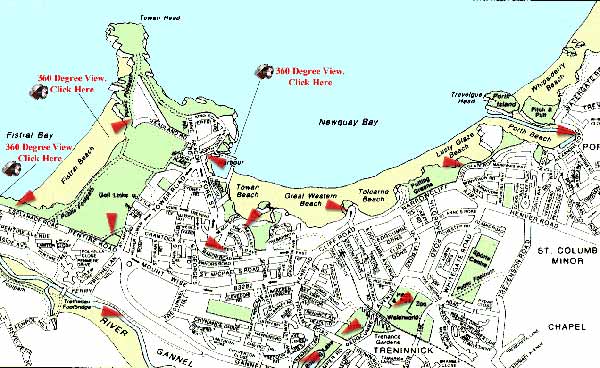
| Newquay and Bournemouth have been racing to work on project for building an artificial reef. It seems like Newquay is one step ahead now that Kerry Black, the world expert from Waikato University in New Zealand, has come to the Cornish main resort to collect data for a £35,000 feasibility study. Kerry Black benefits from his tremendous experience at Narrowneck, Surfers Paradise on the Australian Gold Coast. If the study proves to be favorable, there will another stage of £ 250,000 to achieve the actual project. Anthony Weight, the Cornish engineer who will conduct work, says the reef would be 600 m long and 450 m wide, to be sited at low water off Newquay Bay, consisting of 200 sand-filled 30m long x 3m wide geotextile bags. The idea would be the organize a huge surf festival whenever the perfect reef would create perfect waves. |
|
Web :
www.surfmagic.co.uk/news/article.asp?SP=&v=&UAN=836&from=%2Fnews%2Fsearchresult%2Easp%3F
www.newquay-online.com/
Beach Art : carving the beach never harms Nature
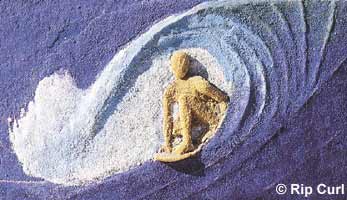
 |
I don't like being on the beach doing nothing. Like anyone I guess. Which means most of the time, the beach is like a road, I use it to go from the carpark to the surf. Lying on the sand idle gets on my nerve but in the same time, I am fascinated by the sand. Feeling warm sand on your skin, letting it flow between the fingers, draw things in it, gazing at sand lines browsed by the wind...all these things are worth spending some time. Then, I met this girl who carves huge things on sand : Mermaid, Neptune, suns and flowers...and even castles. Anyway, because I get to have a pretty good knowledge of the earth geography, I thought I could draw a huge beach worldmap at low tide. Every 3rd week-end in many west European countries, Surfrider Foundation Europe organizes beach cleaning. If surfriders still seems to be reluctant at gathering trash on the beach, the event is getting more and more popular. Last March, that was then a perfect timing to try my 1st beach worldmap. I started working at low tide. It took me full time about 3 hours to draw a 30 m x 20 m flat worldmap. The first job is to find a wide area of flat sand. Then, with a map model, you start drawing latitudes and longitude with a stick . Every square becomes independent where out of your model, you can draw the shorelines with a larger line, your heel for example (hurts pretty bad in the long run). Obviously, islands are kinda tricky. When contours are drawn, you mess around the earth surface (preferably with a rake) to create some contrast with the ocean. That's it ! If you have enough pebble around, you can make the shoreline look more obvious. When the tide is getting in , the first sets starts rolling on the beach and the white water is washing the map away. How fragile earth can be ! |
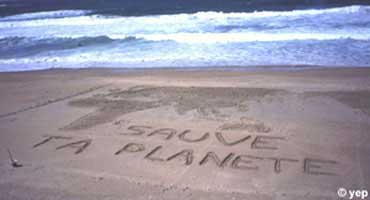
| | NEWS | | ARCHIVES | | ECO-LOGICAL | |
Bell's Beach : Surfing reserve since 1970 !

| When the World Championships took place in Bell's Beach in 1970, the locals already felt that such a fragile environment could easily be trashed by beach crowds. Guys who moved from the City to Torquay to remain off the urban sprawl and live fully the surfing lifestyle were eager to keep that wilderness as long as possible. That's why, after the Championship that sacred Bell's like one of the world surfing capitals, clever guys like the Rip Curl and Quiksilver crews initiated this project of a Surfing Reserve. Which means that, since 1970, the area is fully dedicated to the surf and no construction shall ever be made for any other purposes. An Act has been signed by the Australian Parliament to acknowledge this initiative and 30 years afterwards, it has remained "roughly" the same. It's a shame that no other attempts have been made to create more "Surfing reserves " in Australia or in other parts of the world. |
|

 For the past 14 years, a local volunteer group Surfers Appreciating the Natural Environment (SANE) have helped repair the damage and continue to restore Bell's to its former glory. Building paths, lookouts, replanting species. Take the time and you may see an echidna, a rare marsupial, the Rufus Bristle bird, a hedgehog in the middle of coastal shrubs. Here are their recommendations to preserve the place.
For the past 14 years, a local volunteer group Surfers Appreciating the Natural Environment (SANE) have helped repair the damage and continue to restore Bell's to its former glory. Building paths, lookouts, replanting species. Take the time and you may see an echidna, a rare marsupial, the Rufus Bristle bird, a hedgehog in the middle of coastal shrubs. Here are their recommendations to preserve the place.
-Walk or ride your bike to surf
-Leave your animals at home
-Stay on designated paths
-Stay off the cliff edges which are unstable
-Don't litter.
For further infos, click www.sane.org.au
EXTRA : Shipwreck in Cabo Verde
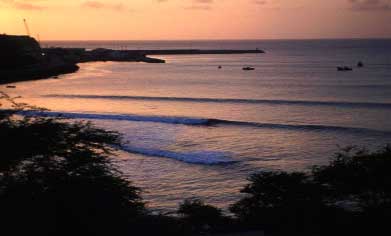
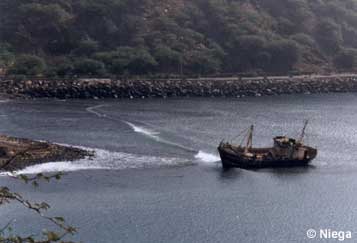
Praia downtown in Santiago owns a very peticuliar urban spot. Although being tucked in a deep bay closed by fairly large jetties, thus suffering the narrow swell window syndrom, the rivermouth left breaks fairly consistenly with SE swells coming from far flung South Atlantic swells. When you consider the break is located 15° North and still catches regularly swells generated more than 5-6000 km away, you must be convinced that some ocean floor makes this place a swell magnet. However, it became a ship magnet when last January a fairly big boat shipwrecked right on the break boulders.
| | NEWS | | ARCHIVES | | ECO-LOGICAL | |
MORE SPOT THREATS AROUND THE WORLD
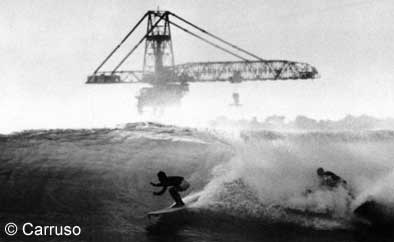
Madeira : Ponto do Sol
| Tabua, in the town of Lugar do Baixo, faces Southwest so it is not the island's most consistent by any means, but it breaks fairly regularly during the winter. It starts to work at about 2 meters (face height) on up. It is usually about half the size of Jardim do Mar. A marina development has been proposed and approved by local. Tabua, has already been affected by the development: work crews have started construction of a breakwall along the point which has been sending back-wash into line-up. Originally, the marina was to cover the entire wave zone. However, a Madeiran surfer named Rodolpho Machado was hired as an architect at the firm to design the marina and he managed to work out a compromise that would spare at least part of the wave. Local officials agreed to build the marina breakwall from the bottom of the point. However, there have been no studies done to determine how much this new breakwall will change the wave. Most surfers feel that the breakwall will create too much turbulence in the line-up. Judging from the effect of the current breakwall along the point, this will probably be the case | .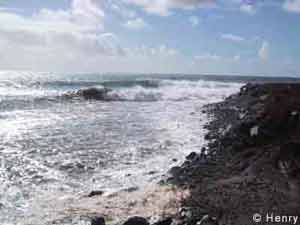 |


Already, construction crews have removed large rocks from the ocean bottom to use in constructing the walls. Many of these rocks have been taken from the point itself - the very rocks over which this wave breaks! Something must be done soon before the wave is completely destroyed. A simple e-mail and letter-sending campaign could perhaps convince local officials to
consider moving the marina to another spot.
Contact Will Henry for support. willhenry@earthlink.net
Baja : Scorpion Bay
 This is Baja, not Scorpion Bay ! |
Probably the most famous right pointbreak in Baja, Punta Abreojos, a.k.a Scorpion Bay, is under the fire of many projects. After having resisted Mitsubishi's attack to create huge salt plans, it's said that a jetty should be built on 2nd point to offer shelter to Japanese shrimpers.
And apparently, the worst is yet to come if the Fonatur's (Mexican Tourism promotion) idea to ease sailing alongside Baja is made a reality. There would be then a new harbor every 150 km, guess where : around pointbreaks ! Californian surfers, accustomed to do Baja desert trips must be spewing and really need to show their protest contacting Surfrider USA. Web : www.surfrider.org |
Chile
: Puertecillo
| Basically, this secret spot is one of the true barelling left reeling on a sandbank tucked behind a headland in a glorious virgin landscape. Now, it needs to be revealed to be saved ! It actually requires a permit that you get by fax to get there and be allowed to camp since years ago, surfers unwillingly started a fire and a huge arson destroyed some part of the forest. Now the whole area is under the threat of the "Hacienda Topocalma". It's a real estate project including condos, golf courses for 50.000 people ! Despite plenty of good intentions, the project may cause severe problems in terms of access and water quality. Obviously, there is also the dark shadow of Marina for yachts which would destroy the potential in Topocalma or Puertecillo. Send your message of support to marejada@hotmail.com Web : www.surfchile.cl |
 |
Puerto Rico : Rincon
A huge chunk of land (10 ha) around Tres Palmas is supposed to be taken over by a real estate plan that would create 12 buildings including 552-room hotel, 60 villas, swimming
pools, tennis courts, restaurants on 25 acres at Steps Beach and another hotel (Manihiki) that would develop another 19 acres of facilities. Join La "Liga Ecologica " or " Pro Bienestar Rincon " in Puerto Rico or Surfer's Environmental Alliance on the US East Coast.
Web : www.damoon.net/sea/
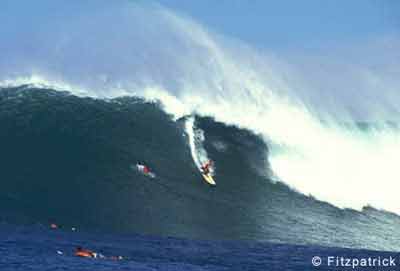
| | NEWS | | ARCHIVES | | ECO-LOGICAL | |
GALAPAGOS : San Cristobal is fine, windward islands under threat
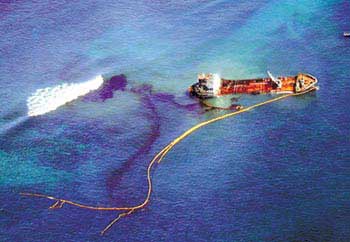 |
At approximately 22:00 local time on January 16, 2001, the tanker Jessica, owned by Acotramar, ran aground at the entry to port Baquerizo Moreno on San Cristobal Island. It belched about two-thirds of its cargo of 240,000 gallons of oil into the crystalline Galapagos waters. Its semi-submerged hulk now rests in the prophetically named Shipwreck Bay, outside the tiny harbor. Many species of unique birds, marine iguanas and turtles are under threat but what about surf spots ? |
Lanzarote: Famara threatened by a fishing port?
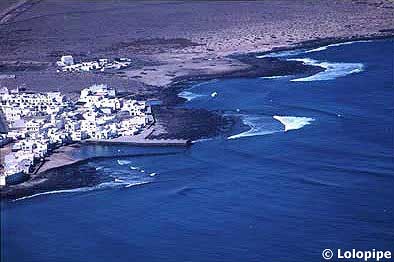
It is a fact that Famara village on the northern coast of Lanzarote island has the appearance of a small Gaelic village which resists the tourist empire extending in a little anarchistic way in the Canaries. But how long still ? From now on, the peaceful village is threatened by the massive arrival of national money which promise the extension of a pier of Caleta de Famara whereas the initial request of the local fishermen related to only a " refugio " equiped with a winch to reassemble their boats for the winter. With this request of minor installation, the authorities proposed a financing of several million pesetas in order to convince the town hall of Teguise to build a port of " pesca deportiva ", whose relatively low construction costs would leave much money to the local instutions to carry out other facilities whereas there are priorities for the village there (nursery, public transport...)
There are thus initially the stake of a lengthened pier which will disfigure one of the rare typical villages in the Canarys, which will probably make disappear good spots like " El Perefil ", " El Cagao ", " El Muelle " and even the best spot around corner (San Juan), while letting carry a threat on the 6 K of sandy beaches which make Famara a true white gold mine for all the concerned tourists of a virgin environment of any harbour pollution. Then, the local community is concerned with this development starter, which could transform the village into a few years in " Playa Blanca " in the south of the island or worse, Puerto del Carmen, high-place of tourism of mass.
It should not be forgotten that Lanzarote's hundred crater and volcanos were declared " Reserve of the Biosphere " by UNESCO in 1993 but this attribution is likely to be called in question if the island does not respect the schedule of conditions of UNESCO. There also exists a characteristic for the zone of Famara and of its islands of the north, whose waters are restricted. Only a limited list of boats is authorized for professional fishing and amateurial fishing is only authorized with the traditional techniques and in any case within the limit of the 5 kgs. How come would they build a tourist fishing harbor if species are theoretically severely regulated there? Other argument called upon by the authorities : it would be a question of offering a new shelter to offer a new sea link with the island of Graciosa, as well as a new access when the conditions of sea are unfavourable via Orzola in the north of the island. There still, the inhabitants of Famara who constituted themselves in association of vicinity, claim that Graciosa moorage is only a mile away and perfectly sheltered.
Therefore, it is about a project disguised to insufflate money in Famara to be turned into long term a new seaside resort intended to accommodate crowd. Some evoke the memory of César Manrique, architect artist, carried to the rank of national hero, which would not have tolerate such a project to be formed. Disappeared in 1993, he fought to protect the island from a wild development and to impose architectural standards intended to keep an unique scenery. It is true that the lanes are clean, the white, virgin walls of all publicity and that the visual impression is that of an architectural unit adapted to the arid volcanic landscape. As an visionary artist, he wanted Famara, its childhood village, off the tourist boom, with an aim of "sanctuarization" so that it remains as a sign of exception and example of the face of the former Canaries for the inhabitants and the tourists ready to spend more for one preserved environment.
The surfers of the island mobilized themselves in mass against this project since it is not only peace, the environment who are threatened but also of the surfing spots. They would be happy that the surfers' international community mobilize itself to bring the maximum of weight in their fight against this project, whose decisions will be made very soon. Then, if you know Famara, one of the best beachbreak to learn to surf in Europe, or if you feel interdependant, send an e-mail immediately in the following way.
Register name, first name, addresses, profession and n° passport or of indentity card, possibly accompanied by a text of encouragement in Spanish and send the whole to Christophe Darracq, a French surfer installed over there, relaying the action of Surfrider Europe to
chrisdarak@hotmail.com.
| | NEWS | | ARCHIVES | | ECO-LOGICAL | |
SCOTLAND : the first wave power plant in Islay !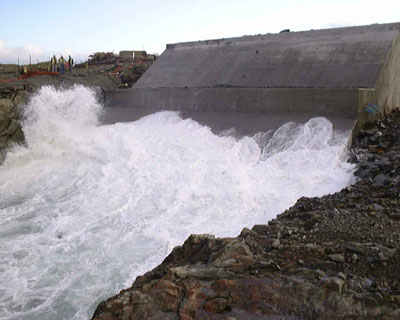
Oceans cover three quarters of the earth's surface and represent a vast natural energy resource in the form of waves. As a general rule coastlines with an ocean fetch of greater than 400km are suitable to Wavegen's products, but even greater resources are available between latitudes 300 and 600 in the Northern and Southern hemispheres. If less than 0.1% of the renewable energy within the oceans could be converted into electricity it would satisfy the present world demand for energy more than five times over. The wave energy collectors used in Wavegen's Limpet and Osprey modules are in the form of a partially submerged shell into which seawater is free to enter and leave. As the water enters or leaves, the level of water in the chamber rises or falls in sympathy. A column of air, contained above the water level, is alternately compressed and decompressed by this movement to generate an alternating stream of high velocity air in an exit blowhole. If this air stream is allowed to flow to and from the atmosphere via a pneumatic turbine, energy can be extracted from the system and used to generate electricity. LIMPET is an acronym for Land Installed Marine Powered Energy Transformer, and is the smallest of Wavegen's energy modules. Islay 's unit is designed to operate right on the shoreline, generating 0.5MW of power for local or island communities.
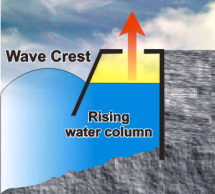
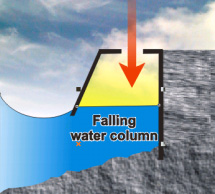
Key innovative features of the shoreline technology are :
- Modular low cost composite steel/concrete manufacture
- Flat pack system build for transport by road rail or sea to site
- Rapid installation and decommissioning
- Minimal environmental impact.
- 60 Year structural design life with 15 year M&E plant upgrades
web : www.wavegen.co.uk
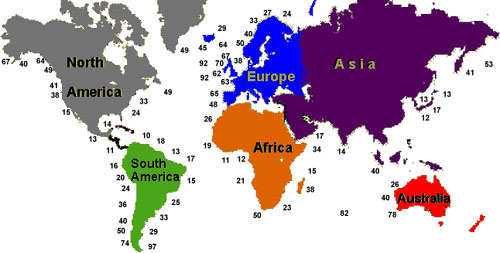
worldmap : Relative Global Wave Energy Density in kW / Mile
| | NEWS | | ARCHIVES | | ECO-LOGICAL | |
JETSKIS : don't let wavebikes ruin our waves !
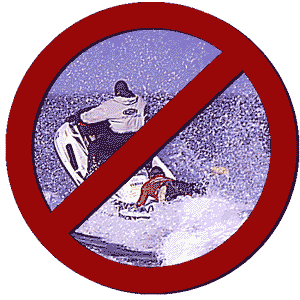
It's no denying that jetskis properly named PWC (Personal WaterCraft-Jet Ski, Sea Doo, and Wave Runner) are spreading in our lakes, rivers and oceans. Ocean use is obviously the more worrying issue for waveriders knowing that our recreation area is getting spoiled. It got even more worrying when the ASP decided to have a continuous service of jets trailing surfers to the lineups. Let's see all the aspects of this major threat to our surfing zone.
The primary reason that jetskis are so harmful to the environment is that they are powered by two stroke engines. These internal combustion engines power either a water jet pump or fully covered propeller chamber and provide the craft with enormous thrust. Unfortunately these engines pollute the water and air, are very fuel inefficient and create an extreme amount of noise, disturbing both wildlife and people alike.Jetskis produce noise levels in the range of 85-105 decibels (dB). (85 Db is above the danger limit). Four-stroke marine motors are 10 times cleaner than direct fuel-injection engines, 40 times cleaner than conventional two-strokes, and don't burn any oil, which is the most environmentally damaging part of the discharge.
Two stroke engines run on a mixture of motor oil and gasoline. According to EPA statistics, two stroke engines are America's number one source of toxic water pollution. Two strokes discharge as much as one third of their fuel and oil unburned into the water and air, which means a two hour ride on a jetski dumps 2.5 gallons of gas and oil into the water. Hydrocarbons found in gas and oil float on the surface of the water and can settle within shallow ecosystems along the shoreline, a critical habitat area. This is the same type of engine that was banned from use in motorcycles years ago because of its contribution to noise and air pollution. It has been estimated that jetskis contribute the equivalent of 4 Exxon Valdez spills to America's waters annually!
Now, the fact that jetskis are invading some spots should be a warning to all of us. Because the ASP have decided this year to use jetskis, it will obvious that they will be made common use in the lineups because jetskiers will see their beloved waterbike in the medias and will feel entitled to have some fun in the waves. One should remember that most countries have a 300 m regulation where jetskis are banned but this does not protect outside, cloudbreaks and bombora breaks. Then, what about law enforcement ? It's common sense that jetskis can easily enter the lienups and escape anytime they would feel control from the coastguards. Another worrying trend is that lifeguards increasingly patrol on jetskis in conditions where they could do a safe rescue and watch with usual techniques (especially the paddle board). Although some specific use can be tolerated (tow-in waves, emergency safety use in gnarly contest waves or stormy seas rescuing), it's no denying that jetskis should not have access to the wave areas. The reason that pushed the ASP to use jetskis is simple : surfers are losing too much time paddling in regards of webcasting and broadcasting medias. Wavelifts enable to have more surfing time, thus, more money from the sponsors but the price to pay is high : the best surfer is not any more the best paddler, the trailing back to the peak can be dangerous for the surfer (see Peterson Rosa cut hand at Bells 2000) and the board and jetskis are made common use in front of millions of people, TV watchers and web-users.
A french petition has been launched against the ASP to warn the organizers against this misuse. Fortunately, jetski is not a rule for every WCT. It's supposed to be used only for long pointbreaks. However, it has to be stated that the last J-Bay Billabong WCT contest cancelled the jetski service because of whales and dolphins.Quiksilver Master organizers have decided as well to cancel it unless Lafiténia Bay gets dangerous.
That's our responsability to protect the waveriding experience as natural and not enduce the engines blow the paddling rules. Here is 7 tips to avoid jetskis nuisances in our lineups !
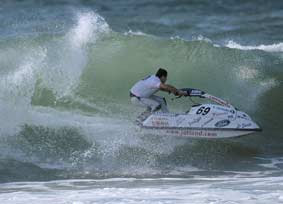
|
1. Don't use a jetski YOURSELF in the waves 2. WARN your jetskiers friend about pollution, noise and ethics 3. CALL the coastguards or the lifeguards if you witness jetskis under the 300m limit 4. Be a jetski warrior, DON'T SHUT UP: detere jetskiers from entering uncontroled lineups 5. Claim the waverider's PRIORITY : no jetskis should get less than 300 m from any waverider. 6. E-MAIL the ASP ( www.asplive.com ) to give your opinion about wavelifts in contests. 7. SIGN IN the petition in Surf session french magazine ( www.surfsession.com/cgi-bin/forum.pl?step=0 )
Web : www.surfrider.org/makingwaves3/jetski6.htm
|
| | NEWS | | ARCHIVES | | ECO-LOGICAL | |
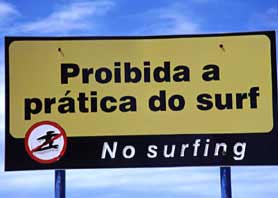
Surfing is banned in Recife area : any offender could be bitten or sent to jail !
Most of the waveriders that came to Maracaipe for the World Surfing Games have not been aware that a stretch of 60 K of beaches around Recife encounter a serious problem : the surf is prohibited. If the numerous shark attacks in the Pernambuco State have been well related worldwide in the surfing media, the consequences have been much ignored. As a matter of fact, the brazilian authorities have sacrificed the "Surfistas" for tourism's sake following this sudden surge of "Tubarãoes" attacks in a few years.
So, what the fuck happen to these peaceful beaches which turn red all of a sudden, like Florida ?
Waveriders name the reason : Boca de Suape ! This rivermouth, 40 K south of Recife has turned into a major harbor in the early 90's. A huge 1-km long jetty was built to cut the south-north sand flow and allow major ships to get in and out. That was the major mistake, all the estuaries north of the Boca de Suape got deprived of the necessary nutrient for starting the food chain. Other worrying factors were the shrimp seashore overfishing and the release of harbor wastes. This is without considering the massive tourism development by the shoreline which lead to sewage spills right in the ocean. That's how sharks changed their food habits in a couple of years. Not only reef sharks (black tip, grey, bulldog) but also tiger sharks who were clearly identified in the slaughters.
First attacks began in the south close to Suape. In 1992, in Candeias, a surfer lost a leg. Then, in Boa Viagem, Claudio Freitas, 22 had his two arms torn off and died soon after being mauled. Up to 1999 where a last one lost a hand at Praia del Cifre close to Olinda. In 5-6 years, there were around 20 attacks, 6 of them being fatal. The main city in Nordeste (3 millions people with neighboorhod) earned a "jaws" reputation : not an easy situation for a tourism resort like Boa Viagem, S of Recife. Most bites occured on surfers who were a few hundred meters from shore. Except for a few bathers that have been turned into surfers by authorities because that would save the tourism economy.
That's how the government found the way out of this bloody mess. Why not putting the blame on surfers' shoulders, who paddle far away from shore and tempt the sharks ? The same people who made possible the ecological changes by allowing the jetty construction and tourism development made up their minds : let's ban surfing. In 1996, beachsigns were set from Olinda to Gaibu (about 60 K) so the surfers would clear out the reefs. What about for those who broke the law ? Some had a jail sentence, most of them had their boards confiscated and a majority stayed out the water afraid of bites and police action. Only in 1998, a law was passed in Pernambuco to made this legal.
So, what happened with Recife's waveriders ? According to Adolfo Rocha, long time surfer and owner of 4 surfshops, there were about 10 to 15 thousands surfers at that time. " That was a fatality. most of the guys sold their gear or put their boards in the back of their garden, waiting for the situation to get better. Seaway, a local successful surfwear brand, organized free trips to Maracaipe but this initiative did not last. The wealthy surfers keep on surfing driving on their own to Maracaipe. Only a handful of guys have demonstrated in front of the Deputacion burning their boards to express their anger. But because of lack of citizen rights, surfers have shut up, convinced that demonstrations never impress the politics. " Try to explain the parents that they need to struggle against this prohibition law. They'll tell you that damage is already done, sharks have become aggressive, they have doubts about what could happen out there, they don't want their kids to take any risks. The surfwear still sells well but the gear has dropped so much. You know, I have a beach house in Paiva, facing a good reef. I bought the house for that location. Anytime I am there and it's going off, I feel so pissed off. It's sad and there no much to do. Maybe, we could have a try at shark nets in front of Acaiaca, a famous short stretch of reefs in Boa Viagem. But, who will pay ? Definitely not the City !
| In 1998, the WQS Hang Loose Pro took place in Gaibu despite the law. Organizers took a major risk running the contest there even though there has never been attacks there. Actually, the police let the local surf there but that tolerance may change any time. This means there has been a sudden surge of surfers to the safe beaches. Localism has been pretty bad at some spots because the situation changed fast. As for the Recife bathers, they usually never swim over the ankles, let alone swimming more than a few meters from the shore. This situation shows us how human activities can provoke ecological disaster with short-term consequences. Sad... |
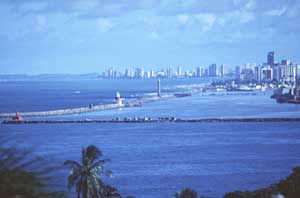 |
| | NEWS | | ARCHIVES | | ECO-LOGICAL | |
Waves are a natural energy. It seems like they will break forever no matter what the humans do on this planet. Unfortunately, it's not true.
First, the water quality has never been so bad because of industrial wastes and sewage dumped into the seas. For example, the spectacular black tides only represent 20% of the global oil spills.
Second,
the coast is a desired piece of land, subject to many pressures from industries,
private properties, tourists... Jetties, piers, breakwaters, harbors,
embankments are built for different purposes like keeping the sand on the
beaches, expanding the shorelines, making use of natural shelters.
Third, phenomenons like the Global warming may affect climate trends and change
the way Lows redistribute the heat on the earth's surface as well as shore
depths, which would be a great mess for spots. The frequency of Niño years may
increase in the future, which would mean bigger swells but less numerous.
We
will start a list of spots destroyed. Most famous examples are Dana Point,
California ( 60's), La Barre, France (early 70's), Praia da Vitoria (Terceira,
Azores)...
We will also report the threats to major spots because of jetties construction :
Maalaea (Maui), Malé (Maldives), Mundaka (Spain), Tenerife spots (Canarys), Le
Moule (Guadeloupe), Kirra (Gold Coast, Australia)...
| Yep has been part of Surfrider Europe since 1996 as Board's Committee member, attending monthly meeting and taking part in most Surfrider's events : beach cleaning, demonstration paddle, free use of texts and photos in the Planet Surf Initiative mag... Yep commitment to environmental concerns will only be growing in the future. We will publish monthly news regarding these topics, writing report of spots' diseases on the planet specifically those affecting the coastline. (c) The Wave Slaves |
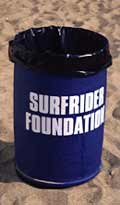 |
| | NEWS | | ARCHIVES | | ECO-LOGICAL | |
|
|
MAJOR OIL SPILL IN NORTHERN FRANCE |
Now, who 's responsible ? It's high time now to understand that since the first 1973 oil crisis, major oil companies don't own ships any more. Most oil shipments are chartered by companies whose country regulations are vague, notoriously known as "Flag of Convenience". Such countries (Panama, Nigeria, Liberia, Greece, Malte) are very tolerant in terms of technical maintenance and labor wages to keep the costs as low as possible. Because these companies who own the ships are extremely hard to convict under international courts, it's very likely that no one will be legally held responsible for that oil spill. TOTAL/FINA who had the shipment ordered is giving away few millions of dollars to keep the public opinion quiet.
Experts claim that many oil tankers reach 25 years of age and that this wave of wrecks will undoubtedly create other disasters. No matter how many of these "tankers of shame" will sink and pollute our spots, keep in mind that these spectacular oil spill only represent 5% of the global oil waste on earth.
Think of it next time you will drive for a surf !
(c) The Wave Slaves
Major oil spills concerning surfshores
|
Date |
Country |
Oil Tanker |
Spill |
Comments |
|
March 67 |
Bretagne / France |
Torrey Canyon |
123 000 t |
180 km of polluted beaches |
|
1967 |
San Juan / Porto Rico |
Ocean-Eagle |
xxxxxx |
|
|
1973 |
Coruña / Spain |
Erkowit |
|
|
|
nov-74 |
Tokyo / Japan |
Yuyo-Maru |
50 000 t |
Collision |
|
janv-75 |
Ste-Croix / Virgin is. |
Michael Lemos |
250 000 t |
|
|
May 76 |
Coruña / Spain |
Urquiola |
100 000 t |
|
|
Feb 77 |
Pacific Ocean |
Hawaiian Patriot |
99 000 t |
|
|
Dec 77 |
South Africa |
Venoil / Venpet |
10 000 t |
Collision |
|
March 78 |
Bretagne / France |
Amoco Cadiz |
230 000 t |
|
|
July 78 |
Chile |
Cabo Tamoro |
20 000 t |
|
|
Aug 83 |
Capetown / South Af |
Castillo-de-Belver |
100 000 t |
|
|
oct-84 |
California |
Puerto-Rican |
10 000 t |
|
|
Aug 86 |
Paray is. / Phillippines |
Maysun |
2 000 t |
|
|
July 87 |
Indonesia |
El-Han |
3 000 t |
|
|
Dec87 |
TablasSt. / Philippines |
Donapaz |
xxxxx |
1540 casualties |
|
March 89 |
Alaska / USA |
Exxon-Valdez |
38 000 t |
2000 km of polluted coastline |
|
June 89 |
Rhode is. / US |
World Prodigy |
2 000 t |
|
|
July 89 |
Sines / Portugal |
Marao |
5 000 t |
40 km of polluted beaches |
|
Dec 89 |
Madeira |
Aragon |
25 000 t |
|
|
sept-91 |
Campos Bay / Brazil |
Theomanis |
50 000 t |
|
|
April 92 |
Mozambique |
Katina P |
60 000 t |
|
|
Dec 92 |
Coruña / Spain |
Aegean Sea |
67 000 t |
150 km of polluted beaches |
|
janv-93 |
Shetlands / Scotland |
Braer |
85 000 t |
|
|
Feb 96 |
Wales |
Sea Empress |
65 000 t |
Pembrokeshire damaged |
|
Dec 99 |
Bretagne / France |
Erika |
12 000 t |
400 km of polluted coast |
| | NEWS | | ARCHIVES | | ECO-LOGICAL | |